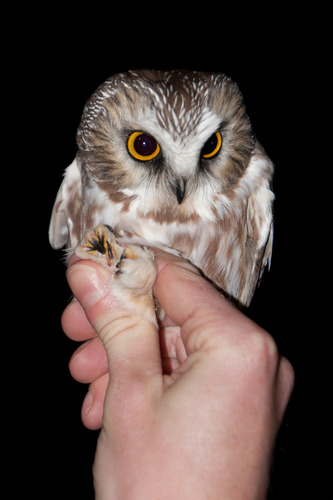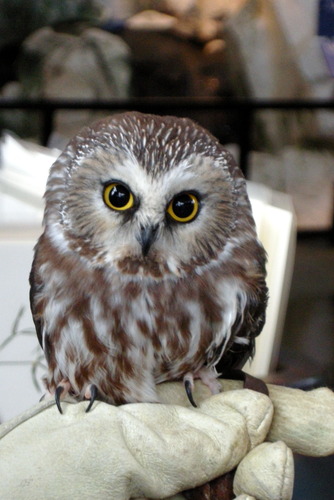northern saw-whet owl
Aegolius acadicusMigration 6
Non-Migrant: Yes. At least some populations of this species do not make significant seasonal migrations. Juvenile dispersal is not considered a migration.
Locally Migrant: Yes. At least some populations of this species make local extended movements (generally less than 200 km) at particular times of the year (e.g., to breeding or wintering grounds, to hibernation sites).
Locally Migrant: No. No populations of this species make annual migrations of over 200 km.
Probably makes local elevational migrations in the mountains of the western U.S. and possibly the Appalachians; fairly extensive north-south movement in east and north. Apparently two main migration corridors exist in the east: Ohio River valley and Atlantic coastal lowlands (Johnsgard 1988). At Cape May Point, New Jersey, 90% of fall migration was completed between mid-October and mid-November (Duffy and Kerlinger 1992). See also Russell et al. (1991) for an account of fall migration at Cape May Point, New Jersey. At Whitefish Point, Michigan, begins arriving in early April; migration peaks in mid- to late April, with a secondary peak in late May (Wilson Bull. 105:356-359).
Aegolius acadicus 7
At just 8 inches in length, the Northern Saw-whet Owl is one of the smallest owl species in North America. Like most owls, this species possesses short legs, rounded wings, large yellow eyes, and a disk-shaped face. Apart from its small size, it may best be identified by its brown body spotted with white above and streaked below as well as on the face. The Northern Saw-whet Owl primarily breeds in Southern Canada and the northern tier of the United States. Breeding populations also exist at higher elevations in the western U.S.and in the Blue Ridge and Great Smoky Mountains in the southeast. During the winter, this species expands its range southward and into lower elevations, including the coastal southeast, the Great Plains, and the southwest. The Northern Saw-whet Owl inhabits forests across the northern part of the continent. In particular, this owl prefers forests that are composed either entirely of evergreen trees or of a mix of evergreen and deciduous tree species. In winter, individuals which have moved south are less tied to a particular habitat type, relocating as new sources of prey become available. Like most owls, the Northern Saw-whet Owl hunts small mammals, including mice, shrews, and voles. This owl uses its excellent hearing to locate prey on the ground in order to fly down and capture it with its talons. Also, like most owls, this species hunts almost exclusively at night, making it difficult to observe. Northern Saw-whet Owls are most visible roosting high in trees during the day or while producing toot-like calls at dusk.
Sources and Credits
- (c) cyric, some rights reserved (CC BY-NC-SA), uploaded by cyric
- (c) Kathy & Sam from Beaverton OR, USA, some rights reserved (CC BY), https://upload.wikimedia.org/wikipedia/commons/3/39/Aegolius_acadicus_-Fossil%2C_Oregon%2C_USA_-juvenile-8.jpg
- (c) Bob Dodge, some rights reserved (CC BY), uploaded by Bob Dodge
- (c) Anita, some rights reserved (CC BY-NC), http://farm1.staticflickr.com/4/4764599_75cfdf9e12_o.jpg
- (c) Museum of Comparative Zoology, Harvard University, some rights reserved (CC BY-NC-SA), http://mczbase.mcz.harvard.edu/guid/MCZ:Orn:230771
- (c) NatureServe, some rights reserved (CC BY-NC), http://eol.org/data_objects/28823123
- (c) Unknown, some rights reserved (CC BY-NC-SA), http://eol.org/data_objects/22709997
More Info
Range Map
iNat Map
| Color | brown |
|---|---|
| Taxonomy:family | Strigidae |










